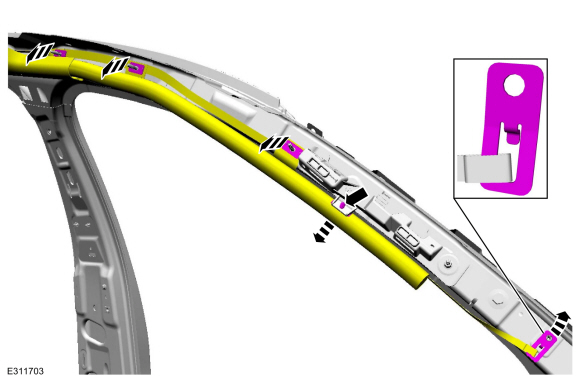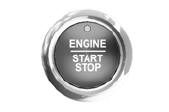Ford Escape: Body Repairs - General Information / General Procedures - Joining Techniques
Special Tool(s) / General Equipment
| Resistance Spotwelding Equipment | |
| Spherical Cutter | |
| Grinder | |
| Plasma Cutter | |
| Air Body Saw | |
| 8 mm Drill Bit | |
| MIG/MAG Welding Equipment | |
| Spot Weld Drill Bit |
Materials
| Name | Specification |
|---|---|
| Metal Bonding Adhesive TA-1, TA-1-B, 3M™ 08115, LORD Fusor® 108B, Henkel Teroson EP 5055 |
- |
| Seam Sealer TA-2-B, 3M™ 08308, LORD Fusor® 803DTM |
- |
| Motorcraft® Metal Surface Prep Wipes ZC-31-B |
- |
Repair
NOTE: Weld Bonding-Squeeze Type Resistance Spot Welding (STRW) Method.
-
Verify the vehicle is dimensionally correct. Repair as required .
Refer to: Corrosion Prevention (501-25 Body Repairs - General Information, General Procedures).
-
Remove damaged panel. Remove only damaged portions of
the panel. Avoid cutting into mating flanges or adjacent parts.
Use the General Equipment: Air Body Saw
Use the General Equipment: Plasma Cutter
Use the General Equipment: Spherical Cutter
-
Mill spot welds and remove damaged portions of the panel to be replaced.
Use the General Equipment: Spot Weld Drill Bit
-
Prepare any damaged flanges on the vehicle using hammer and dolly.
-
Grind the mating surface of the original flanges no
greater the 25 mm where the metal bonding adhesive will be applied.
Use the General Equipment: Grinder
-
Be sure to remove galvanizing on metal. Metal should
have a shiny appearance. Be careful not to damage the corners or thin
the metal. The E-coat should also be remove on the opposite side of the
flange only where spot welds are to be placed. Clean surfaces with
surface prep.
Material: Motorcraft® Metal Surface Prep Wipes / ZC-31-B
-
Dry-fit and clamp the replacement service parts to verify a correct fit.
-
Remove the service part after verifying correct fit and alignment.
-
Prepare the adhesive. Dispense a small amount of
adhesive from the cartridge to make sure of an even flow of both
components. Attach the mixing tip and dispense a mixing tip length of
adhesive to make sure of a correct mix ratio.
Material: Metal Bonding Adhesive / TA-1, TA-1-B, 3M™ 08115, LORD Fusor® 108B, Henkel Teroson EP 5055
-
NOTE: Welding can be carried out anytime during the adhesive curing process, or after the adhesive is fully cured. Welder settings will vary when welding through wet adhesive versus welding through fully cured adhesive. Refer to welder manufacturer's recommended settings for welding through fully cured adhesive. It is recommended to place a shunt weld in an area with no adhesive to make sure of conductivity, particularly when welding through fully cured adhesive.
Create a test sample.
-
Prepare the metal and adhesive as described. Apply a 6 mm - 9 mm bead of adhesive and weld the sample.
Use the General Equipment: Resistance Spotwelding Equipment
-
Place the welded sample in a vice and carry out
destructive weld tests by peeling the scrap metal apart using large
lock-type pliers. Measure the weld nugget to determine that the nugget
meets Ford weld nugget requirements. If the weld nugget does not meet
required size, adjust welder settings until the correct weld nugget size
is achieved.
-
Apply a 6 mm - 9 mm bead of adhesive to the vehicle prepared flange surface.
-
Place the service part(s) in the correct position on the vehicle.
-
When positioned, do not pull the component away from the
vehicle. If repositioning is necessary, slide the service part(s). This
will make sure of correct contact between the components and adhesive.
-
Clamp evenly and tightly. The adhesive contains glass beads which will prevent over-clamping the component.
-
NOTE: Refer to the product label for cure times and handling instructions. Clamps may be removed immediately after the component is welded.
Wipe excess adhesive from the panel before it cures.
-
NOTE: The ends of welding clamps should be insulated on the ends using tape or similar material when welding is carried out.
Complete the spot welding process following Ford recommendations and welder manufacturer procedures and settings.
Use the General Equipment: Resistance Spotwelding Equipment
-
Finish any cosmetic section seams with fiber-filled body
filler. Rough sand the filler, apply conventional body filler after the
adhesive cures and block-sand the area.
-
Mix and apply primer surfacer per Ford-approved paint recommendations.
-
Seal wherever a cosmetic seam sealer is required.
Material: Seam Sealer / TA-2-B, 3M™ 08308, LORD Fusor® 803DTM
-
Refinish per Ford-approved paint recommendations.
-
Restore corrosion protection.
Refer to: Corrosion Prevention (501-25 Body Repairs - General Information, General Procedures).
Repair
NOTE: MAG (Metal Active Gas) Welding Method
-
Mill spot welds and remove damaged portions of the component to be replaced.
Use the General Equipment: Spot Weld Drill Bit
-
Remove damaged panel. Remove only damaged portions of
the panel. Avoid cutting into mating flanges or adjacent parts.
Use the General Equipment: Air Body Saw
Use the General Equipment: Plasma Cutter
Use the General Equipment: Spherical Cutter
-
NOTE: Illustration is generic and not vehicle specific.
Determine sectioning point of component and make appropriate cut.
Use the General Equipment: Air Body Saw
Use the General Equipment: Spherical Cutter
Use the General Equipment: Plasma Cutter
.jpg) |
-
Prepare any damaged flanges on the vehicle using hammer and dolly.
-
Be sure to remove galvanizing on metal. Metal should
have a shiny appearance. Be careful not to damage the corners or thin
the metal. The E-coat should also be remove on the opposite side of the
flange only where spot welds are to be placed. Clean surfaces with
surface prep.
Material: Motorcraft® Metal Surface Prep Wipes / ZC-31-B
-
Dry-fit and clamp the replacement service parts to verify a correct fit.
-
Remove the service part after verifying correct fit and alignment.
-
After removing the damaged sheet metal panel(s), repair
any damaged flanges on the vehicle using a hammer and dolly.
-
NOTE: Illustration is generic and not vehicle specific.
Make a 50 mm wide backing plate from an unused portion of the old or new service part.
Use the General Equipment: Air Body Saw
Use the General Equipment: Spherical Cutter
Use the General Equipment: Plasma Cutter
.jpg) |
-
Measure and cut to fit the replacement service component.
-
NOTE: Illustration is generic and not vehicle specific.
NOTE: 80 to 125 grit sand papers are the recommended for best adhesion.
Remove old adhesive as required and e-coat from mating surfaces of the original component and the replacement part measuring 25 mm on each.
 |
-
Drill plug weld holes in backer plate as indicated.
Use the General Equipment: 8 mm Drill Bit
.jpg) |
-
NOTE: Illustration is generic and not vehicle specific.
Install and clamp backing plate to existing component.
.jpg) |
-
NOTICE: MAG welder must be set up for metal thickness and grade. Refer to welding manufacturer recommendations.
Plug weld as indicated.
Use the General Equipment: MIG/MAG Welding Equipment
.jpg) |
-
NOTICE: MAG welder must be set up for metal thickness and grade. Refer to welding manufacturer recommendations.
NOTE: Illustration is generic and not vehicle specific.
Install service component and plug weld as indicated.
Use the General Equipment: MIG/MAG Welding Equipment
.jpg) |
-
NOTICE: MAG welder must be set up for metal thickness and grade. Refer to welding manufacturer recommendations.
NOTE: Illustration is generic and not vehicle specific.
Seam weld repair area as indicated.
Use the General Equipment: MIG/MAG Welding Equipment
.jpg) |
-
Finish any cosmetic section seams with fiber-filled body
filler. Rough sand the filler, apply conventional body filler after the
adhesive cures and block-sand the area.
-
Mix and apply primer surfacer per Ford-approved paint recommendations.
-
Seal wherever a cosmetic seam sealer is required.
Material: Seam Sealer / TA-2-B, 3M™ 08308, LORD Fusor® 803DTM
-
Refinish per Ford-approved paint recommendations.
-
Restore corrosion protection.
Refer to: Corrosion Prevention (501-25 Body Repairs - General Information, General Procedures).
 General Procedures - Inspection And Repair After Collision Without Supplemental Restraint Deployment
General Procedures - Inspection And Repair After Collision Without Supplemental Restraint Deployment
Inspection
If airbags deploy.
Refer to: Inspection and Repair after a Supplemental Restraint System (SRS) Deployment (501-20B)
.
NOTE:
Deployable devices such as airbags, pretensioners and
inflatable belt inflators, may deploy alone or in various combinations
depending on the impact event...
 General Procedures - Plastic Repairs
General Procedures - Plastic Repairs
Materials
Name
Specification
Plastic Bonding AdhesiveTA-9
-
Repair
NOTICE:
Plastic repairs on vehicles equipped with Advanced Driver
Assistance System (ADAS) must not exceed 12 mils (300 microns) of paint
thickness after refinishing...
Other information:
Ford Escape 2020-2026 Service Manual: Diagnosis and Testing - Engine Ignition
Diagnostic Trouble Code (DTC) Chart Diagnostics in this manual assume a certain skill level and knowledge of Ford-specific diagnostic practices. REFER to: Diagnostic Methods (100-00 General Information, Description and Operation). Module DTC Description Action PCM P0300:00 Random Misfire Detected: No Sub Type Information GO to Pinpoint Test HD PCM P0301:00 Cylinder 1 Misf..
Ford Escape 2020-2026 Service Manual: Removal and Installation - Power Transfer Unit Input Shaft Seal LH
Special Tool(s) / General Equipment 204-069 (T81P-1104-C) Remover/Installer, Front Wheel Hub 205-153 (T80T-4000-W) Handle 307-557Installer, Ball BearingTKIT-2005U-FLMTKIT-2005U-LMTKIT-2006U-FLM/LMTKIT-2006UF/FM 308-968Installer, Input Shaft Seal 308-971Remover, Input Sleeve 308-972Installer, Input Sleeve 308-973Remover, PTU Input Sleeve Hyd..
Categories
- Manuals Home
- 4th Generation Ford Escape Owners Manual
- 4th Generation Ford Escape Service Manual
- Locating the Pre-Collision Assist Sensors
- Drive Modes
- General Procedures - Brake Service Mode Activation and Deactivation
- New on site
- Most important about car
Push Button Ignition Switch

Switching the Ignition Off
When the ignition is on or in accessory mode, press the push button ignition switch once without your foot on the brake pedal.
